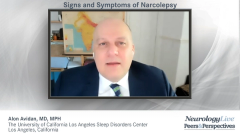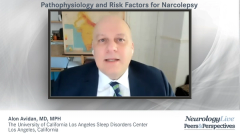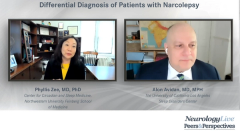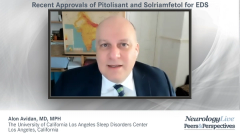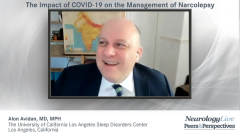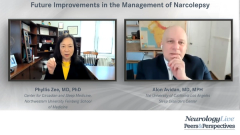
Differential Diagnosis of Patients with Narcolepsy
Key opinion leaders review reasons for diagnostic delay in narcolepsy including medical and psychiatric comorbidities and discuss diagnostic tools such as sleep diaries, polysomnograms, and cerebrospinal fluid testing.
Episodes in this series

Phyllis Zee, MD, PhD: It clearly has distinct symptoms and pathophysiology, yet what is interesting to me is why it takes so long from the onset of symptoms of patients to when they get diagnosed. It is important to note that, because there are a lot of medical and psychiatric comorbidities in patients with narcolepsy, they either get misdiagnosed, or the diagnosis is delayed. Depression is a common comorbidity, for example. Because the orexin system also affects metabolism, the patients tend to be overweight, so perhaps they have sleep apnea as a comorbidity. Those things can coexist, so it is still important to think about narcolepsy even in patients who have sleep apnea or other psychiatric disorders because the delay can be 10 years or longer, and our patients are suffering from that.
Alon Avidan, MD, MPH: Absolutely. One thing I want our audience to recognize, as you said very well, Dr Zee, is that narcolepsy is a diagnosis that is often missed, and it is missed at the most vulnerable age group: the pediatric age group. Narcolepsy is a pediatric disease. It is a pediatric disorder. Initially, when patients present with daytime sleepiness in their school and present even with cataplexy, narcolepsy is often the last thing that folks think about. They often attribute it to hyperactivity or ADHD [attention deficit hyperactivity disorder] or behavioral problems such as laziness or loss of motivation.
I have seen a patient who came to see me because the school nurse and the family physician were convinced that her cataplexy episodes were a manifestation of a psychosomatic illness. Sure enough, she got placed on antidepressants, which actually worked because we know that antidepressants work for folks with cataplexy. It met the criteria, but you are right: The average time from the onset of the disease to when the patient receives a diagnosis is about 10 years. That lag is often during the most critical and vulnerable period of the patient’s life: when they’re pursuing academics, when they are forming relationships, and when they are being given a label. The most critical issue is to improve our recognition of the symptoms and be able to evaluate patients who actually have those red flags.
Phyllis Zee, MD, PhD: The first thing we have to do is get that history and ask about the symptoms that you just spoke about. Then there are some questionnaires. There are screening tools that we can use to assess the level of sleepiness, like the Epworth Sleepiness Scale, which is commonly used. It has a gradation that asks about how likely the patient is to fall asleep under different kinds of social situations. There is also the Swiss Narcolepsy Scale, which focuses on the issue of cataplexy. Do you use that a lot in your practice at the University of California, Los Angeles Sleep Disorders Center?
Alon Avidan, MD, MPH: Yes. Even before giving patients those scales, the 1 tool I use in all my patients is the sleep diary, and I think you would agree. Knowing the duration as well as the regularity of the patient’s sleep-wake behaviors is probably even more important before you use the Epworth Sleepiness Scale and those other more formalized tests because, if you recognize that the patient is having a discordance in their sleep-wake behaviors and they are then making up for lost sleep on the weekends, then that tells you that they are sleep deprived. If you are seeing that delay, the delayed sleep phase circadian disorder is probably No. 1 following depression, perhaps in a similar fashion to having an untreated sleep apnea. That delayed sleep phase circadian disorder is often misunderstood. When patients are sleepy in their morning class because they cannot fall asleep until 2 or 3 in the morning, that is another common tool that can help address sleep duration and regulation.
Phyllis Zee, MD, PhD: I like that, Dr Avidan. The sleep diary is something we do not tend to think about because you are looking at whether this is sleep deprivation, a circadian disorder, or sleep apnea. All these different things could be playing a role. They could certainly be comorbid conditions, so I totally agree.
What about laboratory tests? Does the narcolepsy diagnosis require a laboratory test? We are talking about polysomnography [PSG], which is the overnight sleep study. That is usually followed by a multiple sleep latency test [MSLT], which is a series of 5 naps during the day. What are the criteria for diagnosis using these laboratory tests for narcolepsy?
Alon Avidan, MD, MPH: Following one’s selection of appropriate patients who are generally and critically tired and following the sleep diary, the diagnostic tests are the polysomnogram, the sleep study, and the multiple sleep latency test. The multiple sleep latency test measures the propensity for daytime sleepiness. The multiple sleep latency does not diagnose narcolepsy. If a report from a sleep lab tells you that the patient has certain attributes of daytime sleepiness, that will most likely tell you that, in the differential diagnosis, there are the following conditions with narcolepsy probably being 1 of them, but a lot of other causes of severe sleepiness can have attributes of excessive sleepiness as measured by this formalized polysomnographic testing.
When we order those tests, we are asking patients to complete a sleep diary prior to coming for testing so we can be absolutely sure that the patient has regular and sufficient sleep for their age group, which is more like 7 to 8 hours for everyone over the age of 18. We are also being mindful that the sleep is regular as well; we do not want to test someone who has untreated late-sleep-phase circadian disorder in a lab because the timing of the naps the following day would occur during their habitual sleep time if they do not correct their schedule. Sure enough, they will go in to REM [rapid eye movement] sleep, and that is fairly normal in a circadian disorder but not in a testing for narcolepsy.
The other thing is being mindful that certain medications can hinder or delay the emergence of REM sleep. Antidepressants, in particular SSRIs [selective serotonin reactive inhibitors,] are potent inhibitors and blockers of REM sleep. Before testing, we have patients come off those medications so we are not preventing the diagnosis of narcolepsy because they do not go into REM sleep. That is what we are measuring during both the polysomnogram and during those 4 or 5 naps. We are measuring propensity for sleep by looking at how long it was until the patient fell asleep and measuring pathologic tendencies to fall asleep below certain criteria. Even more important, we are looking at the onset of REM sleep, which should generally be about 90 to 120 minutes. In narcolepsy, on the polysomnogram, on the sleep study prior to the nap study, if a patient goes to sleep in less than 15 minutes, that is even more of a prognostic indicator that something is going on.
Phyllis Zee, MD, PhD: That counts as 1 of the daytime sleep REM periods, right?
Alon Avidan, MD, MPH: Absolutely.
Phyllis Zee, MD, PhD: The diagnosis hinges on us having a good clinical history to identify the signs and symptoms of narcolepsy, which may be something like the Epworth Sleepiness Scale, to get a measure of the severity of sleepiness and these laboratory-based tests, such as the nocturnal sleep study, the PSG, and the MSLT, which are showing the onset of REM sleep. Sometimes, you cannot do all that because the patient is on medications that you cannot get them off, like antidepressants.
Although it is not often used, it could sometimes become more useful in the future to perhaps get the orexin levels in the cerebral spinal fluid. We can send it over to the Mayo Clinic to get that done. Of course, that is not something that most of us do on a regular basis, but that is another option.
Thank you for watching this NeurologyLive® Peers & Perspectives® program. Please subscribe to the e-newsletter to receive upcoming Peer Exchanges® and other great content in your inbox.
Transcript Edited for Clarity
Newsletter
Keep your finger on the pulse of neurology—subscribe to NeurologyLive for expert interviews, new data, and breakthrough treatment updates.

